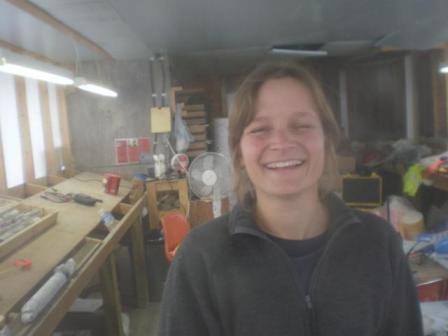-
Biography:
- I am currently conducting a PhD at the Mineral Deposit Research Unit at the University of British Columbia under the supervision of Craig Hart. My research project on the tectonic evolution and structural framework of the Nechako region is funded by Geoscience BC. This is an extremely motivating and challenging project, involving geological observations and interpretations at a regional scale, and integration of multiple analytical and field components. I started this project in January 2010, and thesis completion is expected in December 2013.
Prior to the PhD program, I was a Junior Resource Geologist at Golder Associates Ltd. in Burnaby. For two years, I was involved in resource estimation projects as well as geotechnical assessments taking place at different stages of the mining cycle. This professional experience gave me a good exposure to the mining industry in Canada as I had the opportunity to work on various mines and exploration sites across the country.
Before living in Vancouver, I completed a Master’s degree in structural geology at the University of Quebec (INRS-ETE), investigating the structures and tectonic evolution of Anticosti Island, Quebec. In addition, I conducted a one-year exchange program at the Laval University in Quebec City during my last year of B.Sc. There, I discovered the extensive opportunities that exist in Canada for geologists in the mining and petroleum industries, and this motivated me in pursuing my education and professional career in Canada. My undergraduate studies in geology were completed at the Université Pierre et Marie Curie in Paris, France. I was also regularly involved in summer field projects and internships. I was successively a field assistant for graduate students in the Pyrenean foreland basin of northern Spain, an intern at the Institut Français du Pétrole in Paris, and a field assistant and laboratory technician for a hydrocarbon project in the Quebec Appalachians.
Project: Late Cretaceous to Eocene Tectonic and Metallogenic Evolution of the Nechako Region, Central British Columbia: Insights from Volcanic Stratigraphy and Structural Framework Reconstructions
Episodic but widespread magmatic activity occurred along the Canadian Cordillera from the Late Cretaceous to the Miocene under a post-accretion, dominantly extensional tectonic setting. As a result, thick, discontinuous sequences of Eocene volcanic rocks cover over 15,000 km2 of the Nechako region of central British Columbia. They unconformably overlie Jura-Cretaceous basin clastic sedimentary rocks and are extensively masked by Neogene subaerial Chilcotin flood basalts and Quaternary glacial sediments. These Eocene volcanic rocks and associated structures record an important chapter of the magmatic and tectonic evolution of the Canadian Cordillera and constitute the focus of this study.
In this project, characterization of the nature, thickness and structural framework of Eocene volcanic rocks will provide new insights into the geology of central British Columbia and into the tectonic evolution of the Canadian Cordillera in the Cenozoic. Field mapping techniques combined with geochemical and geochronological analyses will aim at characterizing lithologies, textures and volcanic facies of Eocene volcanic rocks. An improved stratigraphic model based on the identification of mappable units will be proposed for the Eocene period in the Nechako region. A structural framework together with an Eocene thickness model will clarify controls on the distribution, extent and thickness of Eocene volcanic rocks. This structural framework will facilitate identification of structures like calderas, pull-apart basins, pre-Eocene basement structures and structures reactivated during the Eocene.
Outcomes of this study will help assessing the metallogenic potential of Eocene volcanic rocks in the Nechako region. In particular, there will be a focus at clarifying relationships, differences and structural controls on Eocene versus Late Cretaceous Au-Ag epithermal-style deposits hosted in felsic fragmental volcanic rocks. In addition, Jura-Cretaceous basin rocks have some hydrocarbon potential, but their stratigraphy has been extensively complicated by Eocene thermal and structural overprinting. Structural and tectonic models proposed in this study will allow improved reconstruction of the basin architecture and better identification of pre‐Eocene hydrocarbon bearing features.
